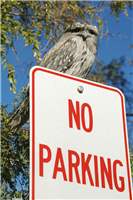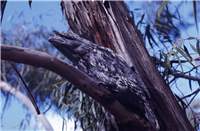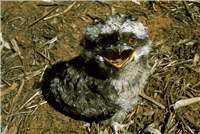Family
Podargidae
Genus
Podargus
Species
strigoides
Threats/Control Methods - Regional
The ongoing large-scale land clearing of mature trees for urban development and agriculture poses the biggest threats for the habitats of this species, as they are unable to easily move to more suitable habitats if their homes are destroyed. Intense bushfires will also threaten the Tawny Frogmouth.
Threats/Control Methods - Local
Free roaming domestic Cats (Felis catus) may attack young birds, however the removal of mature eucalypt trees from suburban areas is the greatest threat to birds attempting to live within suburbia and Canberra's nature reserves.
Local/Urban Actions
Joining a revegetation activity with Greening Australia or Landcare will ensure habitat areas remain available to the Tawny Frogmouth in future. Cat owners, especially those nearby to any nature reserves can limit predation by providing a stimulating indoor environment and an outdoor enclosure for their pets.
Common Names
Tawny Frogmouth, Podargus
Distinguishing Features
This species is probably the best known of all the nocturnal birds, although it can be hard to spot due to its expert camouflage. Its size ranges from 34-52cm across Australia, however birds in this region are at the large end of the range. Its weathered appearance consists of mottled streaks of grey, black, cream and brown, especially complex over the wings and tail. These markings make the bird look like a bark and moss covered tree branch. The grey, broad bill is curved at the tip, with a clump of grey bristles between the bill and the big, pale yellow eyes. Male birds are always mostly grey, while females are either grey or chestnut coloured. In flight, the long, broad wings are noticeable.
Survey Techniques
Call and visual identification.
Species Call
A muffled, low and rapid 'ooo-oom-oom-oom' or 'ar-oom, ar-oom'.
Similar Species
The Marbled Frogmouth (Podargus ocellatus) is very similar, however they are only found in some small rainforest areas of QLD.
Distribution
The Tawny Frogmouth is found across the entire Australian continent and its offshore islands, excluding SA's Kangaroo Island.
Country of Origin
Australia
Conservation (Pet/Pest) Status - Regional
This species is found in low numbers every year, usually in trees with a close proximity to a nature reserve (COG).
Conservation (Pet/Pest) Status - National
Secure, not listed under the EPBC Act 1999.
Associated vegetation community
This species inhabits woodland, open forest, rainforest and tall eucalypt forest.
Limiting Resources
Tawny Frogmouths requires tall, mature eucalypt trees for roosting and nesting and are unable to travel any distance if their habitat is disturbed or if their food supply decreases.
Breeding
The breeding season in this region has been recorded to take place from October until March. Birds are generally on the nest until December and then caring for the young birds until mid March. Their untidy nest is a platform on a tree fork, constructed of large sticks lined with leaves. 2-3 glossy white eggs are laid, needing 30 days of incubation from the male by day and the female by night. The young are ready to fly from the nest after about 4 weeks of parental care.
Behaviour
These are sedentary birds, living in pairs in fairly large territories of 20-80 hectares of woodland country. The well-camouflaged birds are most obvious in this region from November to March, as this is when family groups of up to five birds are active in each territory. They are usually seen sitting on an exposed tree limb, stiffly posed with bill pointed towards the sun and eyes closed, imitating a broken branch. When hunting, a bird will dive swiftly and silently from the perch to the ground or low branch, snatching a large insect or small mammal.
Functional Group
Food Species
The Tawny Frogmouth hunts at night for ground dwelling creatures, including large insects, spiders, frogs, small mammals or small birds.
Predators
Feral or domestic Cats (Felis catus) may predate young birds in their first 6 months of life.
Interesting Fact
When feeling threatened, the Tawny Frogmouth will freeze, trusting its camouflage unless it is touched, when it will react with frightening snapping of their strong yellow-mouthed bills.
References - (reader suitability of references, P=Primary teachers, S=Secondary students, T=Tertiary students and researchers)
Books:Morcombe, M. 2000. Field Guide to Australian Birds. Steve Parish Publishing. Archerfield. Australia P, S, T
Schodde, R. and Tideman, S. (eds) 1990. Reader's Digest Complete Book of Australian Birds (2nd Edition). Reader's Digest Services Pty Ltd. Sydney. P, S, T
Veerman, P. 2003. Canberra Birds: A report on the first 21 years of the garden bird survey. Philip Veerman and Canberra Ornithologists Group. Canberra. S, T
Internet: Canberra Ornithological Group (COG). 2004. Birds of Canberra Gardens. COG and the ACT Department of Urban Services. [online]. Available at:http://garden.canberrabirds.org.au/ P, S, T




 Top
Top Top
Top